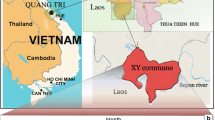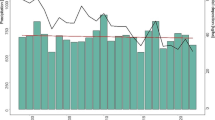Abstract
Water is essential to sustain life, and adequate, safe and accessible supply must be available to all. Millions of people throughout the world do not have access to clean water for domestic purposes. In many parts of the world, conventional piped water is either not available, unreliable or too expensive. One of the biggest challenges of the twenty-first century is to overcome the growing water shortage. Rainwater harvesting (RWH) has thus regained its importance as a valuable alternative or supplementary water resource, along with more conventional water supply technologies. Much actual or potential water shortages can be relieved if rainwater harvesting is practiced more widely. Severe water shortages and extremely fragile ecological conditions necessitate careful attention to water resources conservation and management. Nowadays, cumulative effects of climate change, population increase, development, and industrialization are leading to increased water demand which seeks careful and strategic management of the available resource. In the Ethiopian context, the average annual population growth is about 2.8% and twice of water demand increase. People collect and store rainwater in buckets, tanks, ponds, and wells. This is commonly referred to as rainwater harvesting and has been practiced for centuries. Rainwater can be used for multiple purposes ranging from irrigating crops to washing, cooking and drinking. In this paper, assessment and review are done on effects of climate change, population growth and development on water demand increase. Long-term average annual rainfall was accessed from meteorological data, and minimum numbers of houses data were taken from Ethiopian 2007 census data. Finally, possible amount of water harvested is estimated for domestic and other water uses.
Access this chapter
Tax calculation will be finalised at checkout
Purchases are for personal use only
Similar content being viewed by others
References
Abtew W, Dessu SB (2019) Hydrology of the Blue Nile Basin overview. In: The grand Ethiopian Renaissance Dam on the Blue Nile. Springer Geography. Springer, Cham. https://doi.org/10.1007/978-3-319-97094-3_4
Berhanu B, Seleshi Y, Melesse A (2014) Chapter 6: Surface water and ground water resources of Ethiopia: potentials and challenges of water resources development. In: Melesse et al (eds) Nile River Basin. Springer, New York
CLUVA (2013) Climate change and vulnerability of African Cities. Italy, Napoli
Dowa A, Noel S, Shone G, Barron J, Soussan J (2010) Water and poverty linkages in Africa: Ethiopia case study. Stockholm Environment Institute, Stockholm
FAO (2007) Coping with water scarcity. Challenge of the twenty-first century. FAO, Rome
Hendrix M (2012) Water in Ethiopia: drought, disease and death. Global Majority E-Journal
Johnston R, McCartney M (2010) Inventory of water storage types in the Blue Nile and Volta river basins. International Water Management Institute, Colombo, Sri Lanka. 48 p. (IWMI Working Paper 140). https://doi.org/10.5337/2010.214
Molden D (ed) (2007) Water for food, water for life: a comprehensive assessment of water management in agriculture. International Water Management Institute, London
NAPA (2007) Climate change, national adaptation programme of action (NAPA) of Ethiopia. Addis Ababa
Ndaruzaniye V (2011) Water security in Ethiopia: risks and vulnerabilities’ assessment. Global Water Institute for Africa Climate
Pachauri RK, Meyer LA (2014) Climate Change 2014: Synthesis Report. Contribution of Working Groups I, II and III to the Fifth Assessment Report of the Intergovernmental Panel on Climate Change. (p. 151). IPCC, Geneva, Switzerland
Rettberg S, Beckmann G, Minah M, Schelchen A (2017) Ethiopia’s arid and semi-arid lowlands: towards inclusive and sustainable rural transformation country study. Centre for Rural Development (SLE), Burlin
UNDP (2007) Climate change national adaptation programme of action (NAPA) of Ethiopia. National Meteorological Agency, Ethiopia, Addis Ababa
WaterAid (2013) Rainwater harvesting. www.wateraid.org/Technologies. Accessed 23 Dec 2020
WHO (2014) Progress on drinking water and sanitation. World Health Organization and UNICEF, Luxembourg
World Bank (2007) Urban water supply and sanitation project. World Bank, Ethiopia
World Bank (2012) Ethiopia: climate risk factsheet. The World Bank, Washington, DC
https://www.nationalparks-worldwide.com/eaf/ethiopia/ethiopia-weather.html
Author information
Authors and Affiliations
Editor information
Editors and Affiliations
Rights and permissions
Copyright information
© 2021 The Author(s), under exclusive license to Springer Nature Switzerland AG
About this chapter
Cite this chapter
Jemberie, M.A., Melesse, A.M. (2021). Water Conservation Through Decentralized Rainwater Harvesting Under Climate Uncertainty . In: Melesse, A.M., Abtew, W., Moges, S.A. (eds) Nile and Grand Ethiopian Renaissance Dam. Springer Geography. Springer, Cham. https://doi.org/10.1007/978-3-030-76437-1_20
Download citation
DOI: https://doi.org/10.1007/978-3-030-76437-1_20
Published:
Publisher Name: Springer, Cham
Print ISBN: 978-3-030-76436-4
Online ISBN: 978-3-030-76437-1
eBook Packages: Earth and Environmental ScienceEarth and Environmental Science (R0)




